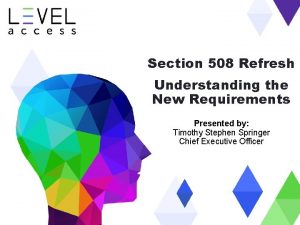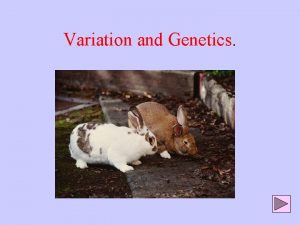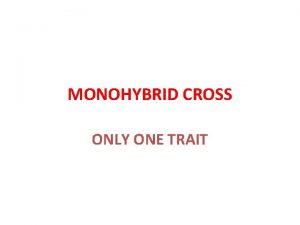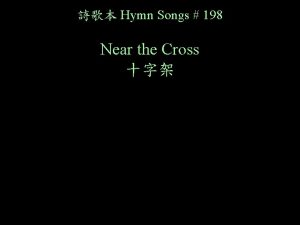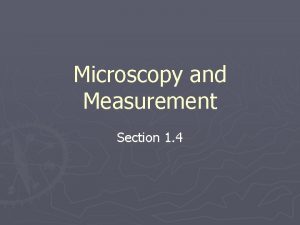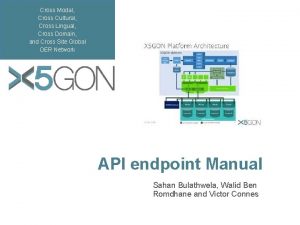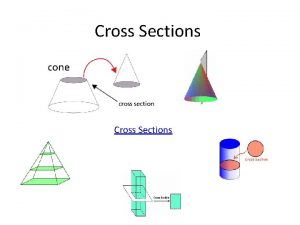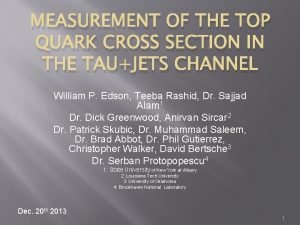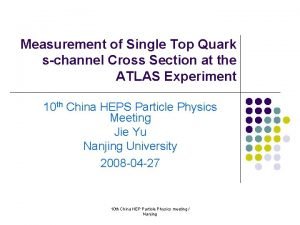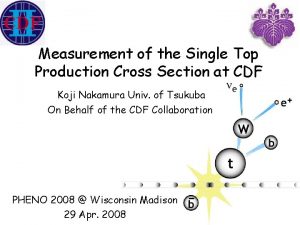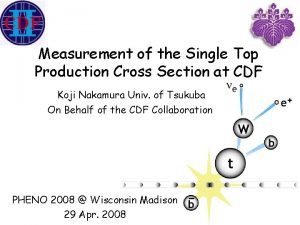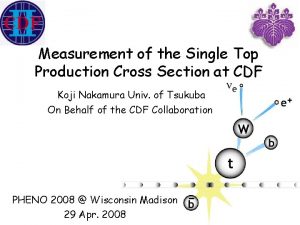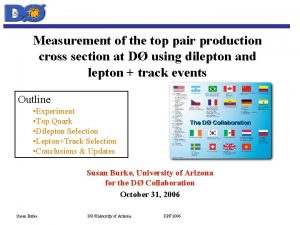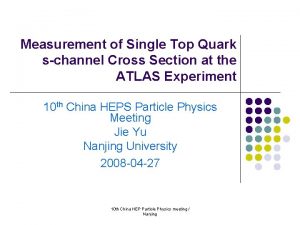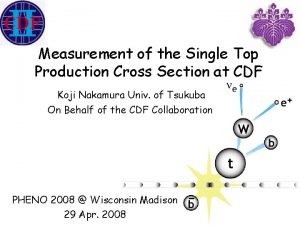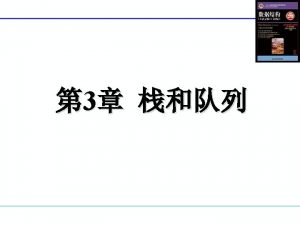Update of the top cross section measurement in


















- Slides: 18

Update of the top cross section measurement in the all hadronic channel P. Azzi, A. Castro, T. Dorigo, A. Gresele Introduction Data Samples Run. I Analysis strategy Kinematical Selection B-Tagging (Secvtx) “Method 1” background Alternative background estimate Future Plans Ambra Gresele – Bologna Univ. & INFN Top Mtg 4/3/03

The all hadronic channel The all hadronic channel: Þ BR is large (46%) Þ S/B is very small Run. I Analysis strategy had 2 steps: Þ A)Tight Kinematic + >=1 btag Þ B) Loose Kinematic + >=2 btag 6 jets-QCD background MC generation used to be very difficult Þ use the data to evaluate the bkg after tagging in shape and normalization Ambra Gresele – Bologna Univ. & INFN Top Mtg 4/3/03

The datasets (data and MC) Dedicated trigger: TOP_MULTI_JET (after Run 143938) Þ Requires: N(jet)>=4 with Et>=15 and Et>125 Ge. V Þ Before Run 143938: L 2 was only Et>130 Ge. V cut Lint~ 100 pb-1 (with good run list, no SVX requirement) Lint~ 69 pb-1 (with good run list and SVX requirement) Þ 1078473 events Events processed through the “REMAKE” procedure used by the other Top analyses + 4. 9. 1. hpt 1 Top. Event. Module info o RAW JET energy information used for NOW! Signal MC: ttop 2 i Þ Extra signal samples produced for systematic evaluation o Different top masses o Different conditions Ambra Gresele – Bologna Univ. & INFN Top Mtg 4/3/03

Run. I vs Run. II dataset kinematical properties Ambra Gresele – Bologna Univ. & INFN Top Mtg 4/3/03

Sample clean-up The following requests are applied for a minimal clean-up of the sample: Þ |Z(vert)|<60 cm Þ Et 2000 Ge. V Þ MET/ Et 6 Ge. V 1/2 o 6% of data events removed To guarantee orthogonality with lepton+jets analysis events with at least one tight lepton (electron or muon) are rejected o 1% of data events removed o On all hadronic signal sample expect 1% of events removed Ambra Gresele – Bologna Univ. & INFN Top Mtg 4/3/03

Kinematical selection optimization (Run. I style) Jet counting definition: Þ Et(raw)>15 Ge. V & |eta|<2 Main background: QCD 2 2 processes with extra jets due to gluon radiation Þ Kinematic very different from tt Use data before tag for the background shape Þ Signal contamination negligible Cuts chosen: Þ 5 N(jet) 8 Þ Et 250 Ge. V Þ Et/ ŝ 0. 75 (centrality) Þ Aplanarity+0. 0035 x 3 Et 0. 55 Ambra Gresele – Bologna Univ. & INFN Top Mtg 4/3/03

Aplanarity Kinematic cuts optimization c e oj Pr n o i t Optimization Ambra Gresele – Bologna Univ. & INFN Top Mtg 4/3/03 Sum. Et 3

Summary table of kinematical selection MJ events Cum. Eff. (%) Trigger 1086208 99 99 1/5000 Clean-up 1017054 96 97 1/3400 Tight Lepton VETO 1009789 96 99 1/3400 130967 73 76 1/600 Sum. Et 11025 45 61 1/80 Centrality 5989 37 83 1/50 Aplanarity 1023 22 58 1/15 Cut Njet Signal inclusive eff (%) Rel. Eff. (%) 10 S/B(*) 1/14 (*)Assuming (tt)=7 pb Ambra Gresele – Bologna Univ. & INFN Top Mtg 4/3/03

Systematics on kinematical selection Efficiency on exclusive hadronic events is 22% (BR=44%) Efficiency on inclusive tt events is 10% Þ Run. I value was 9. 9% using corrected energies The biggest systematic contribution is clearly from the jet energy scale. Since we are using raw jets we: Þ varied the jet energies by +5, -10% Þ Obtained: +24, -38% on the efficiency Þ Run. I value was: 8% For comparison the total Run. I systematic uncertainty was 16%. …Systematic evaluation in progress… Ambra Gresele – Bologna Univ. & INFN Top Mtg 4/3/03

Sec. Vtx efficiency in all-had tt events Given the higher density of jets in all hadronic tt events we went trough the exercise of remeasuring the btagging efficiency following the procedure of CDFNote 6329. Considering five or more jets after kinematical selection we find the following: Quantity All had(Njet 5) L+jets(Njet 3) btag(%) 41. 0 0. 3 43 0. 6 2. 0 0. 3 2. 7 0. 2 F 1 b 0. 004 0. 559 0. 004 44. 9 0. 7 46 1 0. 411 0. 007 mistag (%) F 2 b b-tagevent (%) tag_event (%) 0. 316 Ambra Gresele – Bologna Univ. & INFN 0. 008 44. 1 0. 6 0. 459 45 1 Top Mtg 4/3/03

Background estimate after tagging (Method 1) In the multijet sample we expect the presence of tags coming from true heavy flavor due to the following QCD processes (apart from tt production): Þ Direct production Þ Gluon splitting Þ Flavor excitation The method for this bkg estimate is based on the assumption that the contribution of these QCD processes remains the same (does not increase) as a function of jet multiplicity. The positive tag rate measured on the N(jet)=4 bin is then applied to higher multiplicities (Method 1) Ambra Gresele – Bologna Univ. & INFN Top Mtg 4/3/03

Tag Rate Parametrization & checks The tag rate is parameterized in terms of: Þ Et Þ number of good SVX tracks Þ detector eta Þ Matrix: 6 x 11 X 3 Checks on the N(jet)=4 bin: Cut OBS EXP Delta(%) N(jet)=4 14484 118 -- Sumet 190 173 13 10 8 Centrality 2269 2332 48 -3 2 Aplanarity 409 393 20 4 5 Ambra Gresele – Bologna Univ. & INFN Top Mtg 4/3/03

Positive Tag rate dependence in N(jet)=4 Ambra Gresele – Bologna Univ. & INFN Top Mtg 4/3/03

Tag Rate checks vs. N(jet) before kin. N(jet) Events Tgbl. Jets Obs Exp Delta(%) 4 283952 664735 14484 118 -- 5 75569 222068 4704 4712. 6 67. 5 0. 2 1. 4 6 11259 40067 761 850 28. 5 -10 3 7 and 8 1479 6361 137 133. 6 11. 3 2 9 For N(jet)=6 we see a significant depletion of observed tags. Þ This is inconsistent with the checks from the btag group Þ We are still investigating the technical details with the experts The bin with N(jet)=6 is where we expect the signal to show up once we apply the kinematical requirements. We need to have good agreement before any kinematic is applied. Ambra Gresele – Bologna Univ. & INFN Top Mtg 4/3/03

Alternative background estimate Given the problems seen in the Method 1 background, another method has been investigated. The kinematical variable less sensitive to bias from the request of tag appears to be the Apl+Sumet 3. Þ The shape after tagging is well described by the tag rate parameterization Templates have been created: Þ Signal: tt events with N(tag) 1 Þ Background: data events weighted with the positive tag probability (from the matrix) Ambra Gresele – Bologna Univ. & INFN Top Mtg 4/3/03

Likelihood fit …Still we cannot isolate a signal… Ambra Gresele – Bologna Univ. & INFN Top Mtg 4/3/03

Plans for the future In the current datasets we are not yet able to extract a significant top signal in the hadronic channel in ~69 pb-1 It is interesting to know which S/B we expect in the various cases with the selections described: Þ Full kinematical selection + btag: S/B(expected) ~1/2 Þ Loose kinematical + btag + fit: S/B(expected) ~1/9 Þ Loose kinematical + 2 btag: S/B(expected) ~1/2 – Not optimized yet for 2 tag analysis!!! Future plans are aimed at: Þ Improving the tools (in progress now) o Fixing problems with usage of Secvtx o corrected jet energies o event-by event vertex o QCD background MC bb+2, 3, 4 partons (Alpgen) Ambra Gresele – Bologna Univ. & INFN Top Mtg 4/3/03

Plans for the future (cont’d) Þ Analysis strategy optimization (cross section measurement for the summer): o Reevaluate kinematical selection – maybe optimizing already also for mass? o Require double tags o Use JPB in conjunction with Secvtx Þ Mass analysis (Winter 2004): o Reoptimize kinematical selection (if necessary) o Fit method, jet corrections, tools (in conjunction with mass group) o Improve choice of combination using b/charm info (JPB, Secvtx) o Use Forward tags? Lots of work, but the path is clear. Hope to have results soon! Þ Start giving regular presentation at Top Mtg Ambra Gresele – Bologna Univ. & INFN Top Mtg 4/3/03
 Backup and recovery techniques
Backup and recovery techniques 508 refresh
508 refresh Test cross and back cross
Test cross and back cross Test cross and back cross with example
Test cross and back cross with example Incomplete dominant inheritance
Incomplete dominant inheritance What is the difference between phenotype and genotype
What is the difference between phenotype and genotype In the cross, in the cross be my glory ever
In the cross, in the cross be my glory ever What is balanced occlusion
What is balanced occlusion Chapter 8 section 3 earthquakes and society answer key
Chapter 8 section 3 earthquakes and society answer key Section 2 standards of measurement answer key
Section 2 standards of measurement answer key Microscopy and measurement section 1-4 review
Microscopy and measurement section 1-4 review Hát kết hợp bộ gõ cơ thể
Hát kết hợp bộ gõ cơ thể Ng-html
Ng-html Bổ thể
Bổ thể Tỉ lệ cơ thể trẻ em
Tỉ lệ cơ thể trẻ em Gấu đi như thế nào
Gấu đi như thế nào Tư thế worm breton
Tư thế worm breton Bài hát chúa yêu trần thế alleluia
Bài hát chúa yêu trần thế alleluia Môn thể thao bắt đầu bằng từ đua
Môn thể thao bắt đầu bằng từ đua

